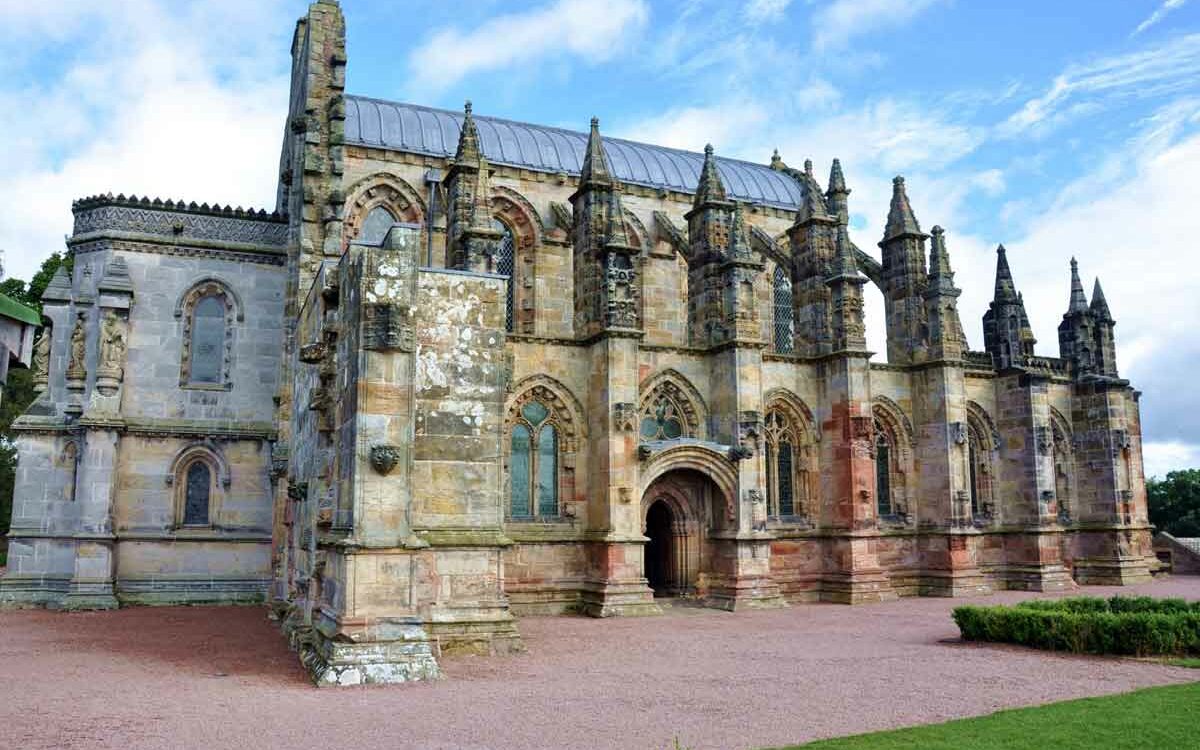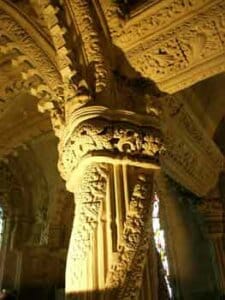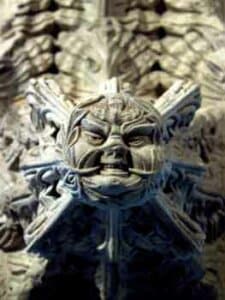
Rosslyn Chapel, also known as the Collegiate Chapel of St Matthew, was founded in 1446 by Sir William St Clair.
Quick facts about Rosslyn Chapel
- William St Clair founded Rosslyn Chapel in 1446.
- The altars were destroyed during the Scottish Reformation.
- Dorothy Wordsworth visited in 1803.
- Queen Victoria visited in 1842.
- In 2006, scenes from Dan Browns Da Vinci Code were filmed in Rosslyn Chapel.
- Today the chapel, part of the Scottish Episcopal Church and still a vibrant place of worship, draws thousands of visitors through its ancient doors.
History of Rosslyn Chapel
In 1446, Sir William St Clair, 11th Baron of Rosslyn and the 3rd and last Prince of Orkney founded Rosslyn Chapel, later dedicated as the Collegiate Chapel of St Mathew.
It seems, according to some sources, that William was encouraged to begin building a house for God’s service as he felt his age, “creeping on him…”
William St Clair was a “very fair man of great stature, straight and well proportioned, humble, courteous and given to building of castles, palaces and churches” and was apparently, “greatly averse to the use of the rack, the tortures of which wrested confessions…”
Unknown
In 1436, as a young man, he was tasked with escorting Princess Margaret, the 12-year-old daughter of James I to the royal court in France where she would marry the Dauphine, later Louis XI of France.
It seems he made a great impression on King Charles VII, who showered him with honours.
It’s almost certain that William also took the opportunity to explore the vast territories controlled by Charles, including Teba where his ancestors had died defending the heart of Robert the Bruce.
Sir Walter Scott
In 1798, Sir Walter Scott took a cottage near Roslin for the summer months, subsequently developing an interest in the St Clair family and the surrounding historic landscape.
Scott’s association with Rosslyn Chapel helped establish its enduring legacy as a captivating historical and architectural landmark.
His poem, “The Lay of the Last Minstrel,” published in 1805, featured the chapel prominently,
‘Yonder, Sir, you behold the far-famed Chapelle, founded in 1446, by the powerful William St Clair, which, whatever we modern critics think of it, was not finished without the aid of an architect who had travelled to Rome, and throughout all Europe…”
Sir Walter Scott
Scottish Reformation
Rosslyn didn’t escape the ravages of the Scottish Reformation and the end of the 16th century was a difficult time for any Roman Catholic family.
Protestant reformers saw the chapel as a “house and monument of idolatrie” and although the St Clairs offered spirited resistance, it was a battle that could not be won.
At the end of August 1592, it was reported that, “the altars of Roslene were haille demolshit.” The Chapel fell into disuse and remained this way until 1736 when some restoration began.
Pagan, Christian and Templar influences

Rosslyn Chapel’s ceiling rises to over forty feet while its breadth is thirty-four feet and its length sixty-eight feet.
Into that relatively small space is crammed an eclectic mix of carvings with Pagan, Christian and Templar influences predominating.
The Mason’s Pillar and the Apprentice’s Pillar are perhaps the best-known of the ancient carvings. They tell us a story of medieval jealousy and anger.
Master Mason was instructed to create a pillar based on an exquisite carving housed in Rome, but before starting work at Rosslyn he travelled to the Eternal City to study the original.
However, in his absence, his apprentice, influenced by a dream, completed the work. On return the mason was so angry he hit the young man with a mallet, killing him instantly.
Apprentice’s Pillar
In a corner facing the organ loft, the carved head of the apprentice complete with scar on his temple looks down, nearby his grieving mother surveys the scene, while the mason peers from another dark corner.
On the architrave joining the Apprentice’s Pillar is a Latin inscription, which says, “Wine is strong, a King is stronger, women are stronger still but truth conquers all.”
One of the most intriguing carvings is the Knight on Horseback which may be a representation of William St Clair, the first of the St Clair family to settle in Scotland.
The legend surrounding William tells the story of his bringing a small piece of the Holy Cross (Holly Rood) to Scotland. However, an alternative theory is that the figure behind the knight may be Queen Margaret who married Malcolm Canmore, King of Scotland in 1070.
While there are many fascinating carvings around the building, the carvings of Indian corn or maize tucked away above one of the window arches have been identified as being a plant unknown in Britain at the time the chapel was built.

Addressing this mystery, the present Earl of Rosslyn poses the question, “ Is it possible that knowledge brought home by Prince Henry (a seaman from Scotland’s Orkney Isles) passed to his grandson William St Clair, the chapel’s founder?
This question re-opens the debate about Columbus’s discovery of America. Was somebody there before him?
Legends associated with the Knights Templar at Rosslyn flourish.
It is said that in sealed vaults beneath the chapel lie the remains of ten Barons of Rosslyn dressed in their full armour, and of course, the chapel will also be forever linked with the Holy Grail.
Dan Brown’s Da Vinci Code
It’s difficult to discuss the St Clair family and Rosslyn Chapel without mentioning Dan Brown’s Da Vinci Code and the hype generated by both the book and the movie.
Peter St Clair-Erskine the 7th Earl, who took up the reins in 1977, took a pragmatic view of the chapel’s leading role. He said, “All these claims, suppositions and theories add to the Chapel’s aura of intrigue and mystery and bring to Rosslyn a splendidly diverse range of visitors.”
More feature articles:
- Magdalen Chapel
- Calton Hill
- Old Calton Burial Ground
- Real Mary King’s Close
- Edinburgh Playhouse Theatre
Others were less understanding and some scholarly voices were loudly raised in concern that the family’s reason for building the chapel was lost in the noise created by the Da Vinci Code.
Historian Dr Louise Yeoman, condemning those who believed Rosslyn Chapel was at the centre of a conspiracy, reminded the world that, “William Sinclair built this beautiful church so that Mass could be said for the souls of his family.”
For those with the opportunity to take a closer look they will find, according to Britton in his Architectural Antiquities of Britain (1812) a building, “I believe may be pronounced unique, and I am confident it will be found curious, elaborate and singularly interesting, impossible to designate by any given familiar terms.”
It’s an apt description considering William’s plans for the building were that it should be one of, “curiosity and splendour.”
Roslin Glen
If time allows the beautiful wooded Roslin Glen is worth exploring. it’s a lovely walk that passes close to the remains of the medieval Rosslyn Castle, sacked by Oliver Cromwell’s army in 1650.
The castle is now a holiday home owned by the Landmark Trust.
The area was also the site of the Battle of Roslin fought between Scottish and English armies during the Scottish Wars of Independence in 1303.
Rosslyn Chapel: visitor information
Rosslyn Chapel lies in the village of Roslin, around six miles from Edinburgh. if you’re lucky and the traffic is quiet, driving time from the centre of Edinburgh is around 30 minutes.
A more convenient option might be the bus which you can catch from the city centre. Check out the Lothian Buses timetable to plan your journey.
Although the building is quite small, there are plenty of nooks and crannies to investigate, so you should give yourself plenty of time to explore.
This wonderful place is open all year except for the 24, 25, and 31 December and 1 January. To avoid the summer crowds, the off-season is a good time to visit.
The visitor centre (the entry point for visitors) includes a Da Vinci Code display. A cafe and shop add to what is a unique experience.
- For further information on booking tickets, admission times and help planning your visit, go to the Rosslyn Chapel website.